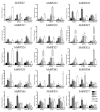Genome-Wide Analysis of BBX Gene Family in Three Medicago Species Provides Insights into Expression Patterns under Hormonal and Salt Stresses
- PMID: 38891967
- PMCID: PMC11171683
- DOI: 10.3390/ijms25115778
Genome-Wide Analysis of BBX Gene Family in Three Medicago Species Provides Insights into Expression Patterns under Hormonal and Salt Stresses
Abstract
BBX protein is a class of zinc finger transcription factors that have B-box domains at the N-terminus, and some of these proteins contain a CCT domain at the C-terminus. It plays an important role in plant growth, development, and metabolism. However, the expression pattern of BBX genes in alfalfa under hormonal and salt stresses is still unclear. In this study, we identified a total of 125 BBX gene family members by the available Medicago reference genome in diploid alfalfa (Medicago sativa spp. Caerulea), a model plant (M. truncatula), and tetraploid alfalfa (M. sativa), and divided these members into five subfamilies. We found that the conserved motifs of BBXs of the same subfamily reveal similarities. We analyzed the collinearity relationship and duplication mode of these BBX genes and found that the expression pattern of BBX genes is specific in different tissues. Analysis of the available transcriptome data suggests that some members of the BBX gene family are involved in multiple abiotic stress responses, and the highly expressed genes are often clustered together. Furthermore, we identified different expression patterns of some BBX genes under salt, ethylene, salt and ethylene, salicylic acid, and salt and salicylic acid treatments, verified by qRT-PCR, and analyzed the subcellular localization of MsBBX2, MsBBX17, and MsBBX32 using transient expression in tobacco. The results showed that BBX genes were localized in the nucleus. This study systematically analyzed the BBX gene family in Medicago plants, which provides a basis for the study of BBX gene family tolerance to abiotic stresses.
Keywords: BBX; alfalfa; gene expression; stress response; transcription factors.
Conflict of interest statement
The authors declare no conflict of interest.
Figures









Similar articles
-
Genome-wide identification and characterization of Calcium-Dependent Protein Kinase (CDPK) gene family in autotetraploid cultivated alfalfa (Medicago sativa subsp. sativa) and expression analysis under abiotic stresses.BMC Plant Biol. 2024 Dec 23;24(1):1241. doi: 10.1186/s12870-024-05993-7. BMC Plant Biol. 2024. PMID: 39716096 Free PMC article.
-
Genome-wide Characterization of the MBF1 Gene Family and Its Expression Pattern in Different Tissues and Under Stresses in Medicago truncatula and Medicago sativa.Int J Mol Sci. 2025 Jan 8;26(2):455. doi: 10.3390/ijms26020455. Int J Mol Sci. 2025. PMID: 39859171 Free PMC article.
-
Genome-wide identification, phylogenetic, and expression analysis under abiotic stress conditions of LIM gene family in Medicago sativa L.PLoS One. 2021 Jun 30;16(6):e0252213. doi: 10.1371/journal.pone.0252213. eCollection 2021. PLoS One. 2021. PMID: 34191816 Free PMC article.
-
Medicago2035: Genomes, functional genomics, and molecular breeding.Mol Plant. 2025 Feb 3;18(2):219-244. doi: 10.1016/j.molp.2024.12.015. Epub 2024 Dec 30. Mol Plant. 2025. PMID: 39741417 Review.
-
Multi-layered roles of BBX proteins in plant growth and development.Stress Biol. 2023 Jan 6;3(1):1. doi: 10.1007/s44154-022-00080-z. Stress Biol. 2023. PMID: 37676379 Free PMC article. Review.
Cited by
-
Transcriptomic exploration yields novel perspectives on the regulatory network underlying trichome initiation in Gossypium arboreum hypocotyl.Front Plant Sci. 2025 Jul 2;16:1604186. doi: 10.3389/fpls.2025.1604186. eCollection 2025. Front Plant Sci. 2025. PMID: 40672567 Free PMC article.
References
MeSH terms
Substances
Grants and funding
LinkOut - more resources
Full Text Sources
Miscellaneous

